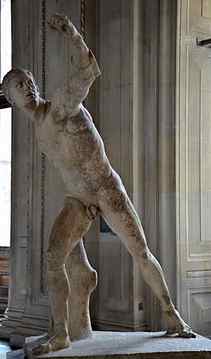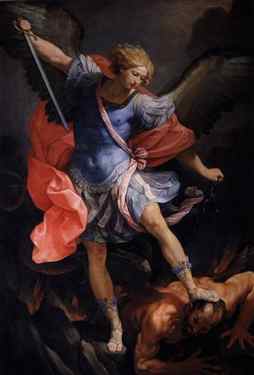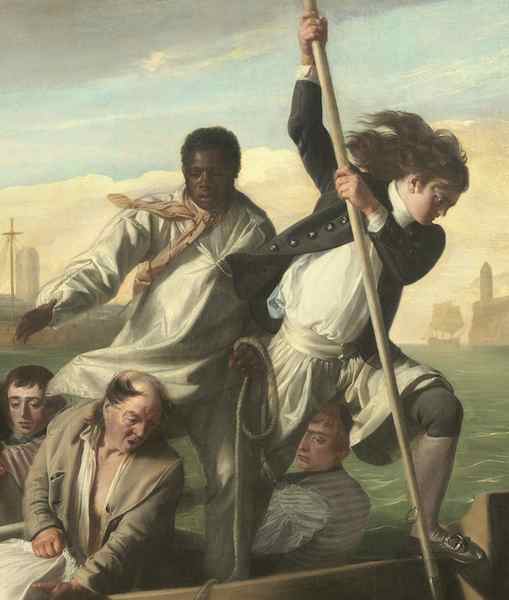John Singleton Copley, Watson and the Shark
The career of John Singleton Copley is a story that can be told in two distinct chapters. The first part, which extends until 1774, tells the story of his American career, one that primarily unfolds in Boston (with a productive side trip to New York). But when political concerns became too unpredictable for a painter who wished to remain as neutral as the situation would allow, Copley sailed from Boston to London. This departure opened the second chapter in Copley’s career, that which takes place in London after a tour of the Continent. This change in locale, from the New World to the Old World, necessitated that Copley reassess who and what he painted.

John Singleton Copley, Gulian Verplanck, 1771, oil on canvas, 91.4 x 71.1 cm (The Metropolitan Museum of Art)
Portraits!
Indeed, an examination of Copley’s oeuvre prior to his departure from Boston indicates that the overwhelming majority of his paintings were portraits. The reason for this artistic output is rather simple: the only real market for art in the American colonies was for portraiture, and Copley, ever the businessman, was willing to provide the art seekers around him exactly what they wanted. His clientele while in Boston comprises the political and economic elite of his day: powerful politicians, elite lawyers, wealthy merchants, and commanding officers amongst many others.
Once relocated to London, however, Copley began to appreciate how different the art market was in England compared to Boston. To be certain, there was a market for portraiture in London. However, the artistic elite in Britain (and elsewhere in Europe) at the end of the eighteenth century no longer wished to paint simple portraits—pictures that recorded what a person looked like—but instead aspired to paint large-scale history paintings. While these often-immense compositions could, of course, be filled with likenesses, there was the higher, more elevated goal of delivering a morally uplifting message to those who viewed them. Benjamin West’s The Death of General Wolfe (1770) is but one example. Painted several years before Copley arrived in London, West not only shows what people looked like—and the image is, in fact, filled with recognizable portraits—he also painted a scene that elevates a British general to a nearly Christ-like level.

Benjamin West, The Death of General Wolfe, 1770, oil on canvas, 152.6 x 214.5 cm (National Gallery of Canada)
There was no such market for paintings such as these when Copley lived in Boston. But when setting up his London painting studio, Copley was immediately aware that if he aspired to be a great painter, he would be required to turn his artistic talents towards historical compositions. To be certain, Copley completed the occasional portrait during the remainder of his career. When compared to historical compositions, portraits were more quickly painted and could provide the artist with quick access to funds. However, the artist preferred to focus his energies on large-scale history paintings during the remainder of his career. His 1778 masterwork Watson and the Shark is but one example of this change in his oeuvre. Painted less than three years after his arrival in London, Watson and the Shark demonstrates the ways in which Copley had quickly assimilated artistic lessons from his European Grand Tour.

John Singleton Copley, Watson and the Shark, 1778, oil on canvas, 182.1 x 229.7 cm (National Gallery of Art)
Brook Watson—and the Shark
The Watson of the painting’s title was Brook Watson, a one-time orphan who eventually became Lord Mayor of London. Watson was born in 1735 in Plymouth, England. He was eventually sent to Boston, presumably after the death of his parents, to live with a merchant named Levens, a man who was likely a distant relative. Levens was actively engaged in trade around with the West Indies, and by time Watson was a teenager, he was actively employed as a member of the crew in one of Levens’s ships. Life changed in 1749, however, when the then fourteen-year-old Watson decided to take a swim while the ship was at anchor in Havana’s harbor. Having discarded his sailor’s woolen garments—clothing that would have been very heavy when wet and impractical when swimming—Watson entered the warm water. Shortly thereafter he was attacked by a shark. Watson’s own account, written in the third person in April of 1778 (when Copley’s painting was exhibited at the Royal Academy), stated that the shark struck three times. “In the first attack, all the flesh was stripped off the bone from the calf downwards; in the second, the foot was divided from the leg by the ancle. ” Watson further stated, “at the very instant he was about to be seized the third time, the shark was struck with the boat hook and driven from his prey.” This is the precise moment Copley depicts in Watson and the Shark. Given what we know about Watson and his future life, it is a moment when we know the youth will live, but are surprised that it can be so.

The shark attacks (detail), John Singleton Copley, Watson and the Shark, 1778, oil on canvas, 182.1 x 229.7 cm (National Gallery of Art)
Indeed, it is a painting filled with drama and action. The composition contains ten figures and a tiger shark, a carnivorous fish so large that its body extends beyond the confines of the painting. Clearly, the main figure of the composition is the fair-haired Watson. He passively floats in the foreground, his feet towards the edge of the painting, his head towards the middle. His left arm is alongside his body while he uses his right arm to reach towards the men in the boat who attempt to rescue him. His left leg kicks towards the surface, while the right leg—already dismembered below the knee—seems to disappear downwards in the water. He looks upwards towards the boat filled with his rescuers in the middle ground, unaware, it seems of the imminent approach of the shark from the right.

Fighting warrior, known as the Borghese Gladiator, c. 100 B.C.E., 199 cm (Louvre) (photo: Carole Raddato, CC BY-SA 2.0)
Although subtle, the figure of Watson demonstrates the ways in which Copley was incorporating artistic references into his own compositions. If Watson were to stand up, his body would have the same overall position as that of the Borghese Gladiator—one of the most famous of classical works in the eighteenth century (the version Copley likely saw in the Louvre in Paris is a first-century Roman copy after a third-century B.C.E. Greek original). It is also similar to a figure within Raphael’s Transfiguration (1516-1520), a painting Copley saw at the Vatican. In a letter to his wife, Copley stated that this painting was “allowed to be the greatest picture in the world.” Moreover, Watson’s head, which Copley has painted in profile, is a nearly identical copy of the head of one of the sons in the famous Laocöon statue, a work Copley saw while visiting the Vatican. In fact, Copley so admired this famous work the he own a small cast of it.
But it is not only Watson that demonstrates Copley’s ability to cull from the famous art made before him. Indeed, this composition is filled with artistic references that his audience would have recognized—and most of these references are taken from paintings that are religious in subject. This is not surprising when one considers that one of the themes of Watson’s own life was that of the salvation that can follow a tragic event.
In regards to imagery, for example, the two men on the left side of boat each extend their right arms downwards to rescue Watson. Copley seems to have borrowed this particular pose from Raphael’s The Miraculous Draught of Fishes (1515-16), a large-scale preparatory drawing that was then in London (and is now in the collection the Victoria and Albert Museum). Copley seems to have liked this religious narrative, for he also owned an engraving after Peter Paul Rubens’s own Miraculous Draught of Fishes (1618-19). The standing figure in the boat, the sailor who wears the naval pea coat and is set to strike the shark with the boathook, looks similar to various versions of St. George (who kills a dragon) or St. Michael (who casts Satan from heaven). Raphael’s St. George and The Dragon (1504-06) and Guido Reni’s St. Michael the Archangel (1636, below) are but two possible influences.

Guido Reni, St. Michael Slaying the Devil, c. 1636 (Santa Maria della Concezione, Rome)
Clearly, Watson and the Shark is an energetic and emotional work. In order to enhance the emotional drama of this event, Copley referenced a well-known treatise of facial expressions. Charles le Brun is most remembered today for his Méthode pour apprendre à dessiner les passions (1698), a posthumously published artistic treatise that explored how emotions manifest upon the human visage. Even a century later, artists referred to le Brun’s work to more accurately convey ideas about human emotions.
When applied to Copley’s Watson and the Shark, for example, we can see that the figure at the prow of the boat with the weapon contains the facial expression that le Brun assigns to “Attention.” The sailor at the far left with his furrowed brow and downward turned mouth mirrors that for le Bruns’s “Horrour.” Likewise, the other standing figure in the boat—the man of African descent who holds the coiled rope—conveys le Bruns’s idea of “Compassion.”
Looking at the faces of the men in the boat, we can see that we have a variety of different kinds or types of people. The young are present, so too are the more elderly. We can say the same about them in regards to wealth. Some seem to be simply dressed sailors. The man standing with the boat hook, however, is dressed in a more affluent way. Note his leather shoes with metal buckles, his silk stockings, and his new navy coat.

Man with boat hook and African American figure (detail), John Singleton Copley, Watson and the Shark, 1778, oil on canvas, 182.1 x 229.7 cm (National Gallery of Art)
The inclusion of the man of African descent standing next to him is an interesting inclusion. Copley has giving this figure a place of particular compositional importance, and he alone holds the rope that links the victim to the boat. Clearly, this is a sympathetic likeness, and whoever the sitter was, Copley seems to have had a particular fondness for him. Indeed, Copley painted him twice. Entitled, quite simply, Head of a Negro (1778) when it was sold after the death of Copley’s oldest son, it was described as Head of a Favourite Negro. When compared with other eighteenth-century (and, to be fair, nineteenth-century) images of Africans, Copley’s paintings seem both honest and dignified.
Left: figure with boathook (detail), John Singleton Copley, Watson and the Shark, 1778, oil on canvas, 182.1 x 229.7 cm (National Gallery of Art); right: illustration of “Attention” from The Compleat Drawing Master, After Charles LeBrun, engraving (London, 1763)
Watson must have approved of this depiction, for records suggest that Watson himself had commissioned the work. His will, written in 1803, stipulated that the painting was to be donated to “the Governors of Christs Hospital…as a testimony of the high estimation in which I hold that most Excellent Charity and that they will allow it to be hung up in the Hall of their Hospital as holding out a most usefull Lesson to Youth.” That lesson was clear. Watson, a former orphan himself, had not only prospered, he had become an immensely wealthy man of significant political importance. And he had done all of this on a wooden leg. His story—as pictorially represented by Copley’s painting—was to serve as a kind of visual inspiration for the orphans at Christ’s Hospital.
To this end, Watson and the Shark is similar in some ways to Benjamin West’s earlier painting The Death of General Wolfe. Both were ambitious paintings of a recent event that aspired to morally instruct by the example of a great man. And like West’s painting, Copley’s composition is part fact with some artistic invention. Indeed, although Copley took great care with this painting, it would be inaccurate to say that it depicts a kind of absolute truth. Copley, a transplanted Bostonian living in London, had never visited Cuba, and he was forced to base his depiction of the Havana harbor on engraved prints—not all of which were accurate. Likewise, he had likely never seen a tiger shark, and there are inaccuracies in the ways it is painted. But despite these shortcomings, the painting achieves its goal in requiring the viewer to emotionally respond to a (nearly) tragic event.
As such, Watson and the Shark retains a special place within the history of late-eighteenth-century English Romanticism. In many ways, Watson and the Shark made Copley’s fame in London. Already an Associate of the Royal Academy of Arts when it was exhibited at the annual salon in the spring of 1778, he was elected to full membership less than a year later. It also represents the Copley’s “London-ification” as he moved away from the portraiture that had made his fame in Boston to ambitious historical compositions that more fully embraced the British art market.
‘The Boat that Won the War’: Film featuring ‘Craftsman,’ WWII boat to screen free on Veterans Day in Eureka

A free screening of a new “Craftsman” documentary, “The Boat that Won the War,” will be shown at the Eureka Theater on Saturday in commemoration of Veteran’s Day. A historic World War II Higgins Boat was pulled from the bottom of Shasta Lake and underwent a four-month preservation project at Blue Ox Millworks during the summer of 2023. Those who worked to preserve the boat will get to see the documentary for the first time along with the community.
A family had purchased the decommissioned boat for about $200 in the 1940s, using the craft to get to their vacation home on the lake, said Eric Hollenbeck, co-founder of Blue Ox Millworks with his wife Viviana.
The boat sat on the bottom of Shasta Lake for decades until James Dunsdon pulled it out.
The four-month project prepared the boat for a future display in a museum, what Hollenbeck called a terrific responsibility and honor.
He said the boat and he speak the same language — he was drafted out of Eureka to serve during the Vietnam War and returned home. He said the story of the boat is similar to those who served: Veterans reach a fork in the road when they return to civilian life — finding a way to contribute to society or winding up on the “scrap heap.”
“I ain’t saying that you got to be a brain surgeon or that you got to be a nuclear physicist …” he said. “If you can make four little girls giggle and squeal, you have just become a contributing member to civilian society,” referring the the family who first purchased the boat.
The ramp that helped troops land in shallow water later served as a platform for the girls to jump into Lake Shasta.

Hollenbeck said the boat was in six D-Days, was sunk twice and repaired, and has 6 campaign Bronze Stars. He said this is the last Higgins boat with original paint, with others having been restored to showroom quality.
“It was imperative we stopped that deterioration right in its tracks,” he said.
He likened the process of vacuuming out the silt to an archeological dig, as they ran it through screens to look for artifacts. He said preserving the boat, not restoring it, is important because the boat’s time with the family on the lake is as much of a chapter in her life as her time in war.
The boat has since been moved to the hometown of the inventor, Andrew Jackson Higgins, in Seward, Nebraska, in the National Guard Museum. The boat left Eureka on July 3.
“Veterans Day provides an important opportunity for us to honor those who have served our country,” noted Eureka Mayor Kim Bergel in a prepared statement as part of a Eureka press release. “Eric is an incredible craftsman and is known in our community for his work preserving our local historical architecture. He is a mentor to local youth and is a mentor and a friend to many of our community’s honored veterans.”

In 2014, Hollenbeck founded the Blue Ox Veterans Program for Returning Vets, an around two-year project with veterans working on a replica of the hearse that carried Abraham Lincoln, now in Springfield. He said they are now getting a new program started with veterans to build a craftsman village.
According to a news release, in 2019, Hollenbeck was presented with the Humboldt Hero Award to honor his military and community service. Blue Ox Millworks recently reached its 50th year.
The screening is presented by the City of Eureka and the Humboldt Del Norte Film Commission.
Hollenbeck said nobody at Blue Ox has seen the documentary yet, and they are excited to see how it turned out. 19 episodes of “The Craftsman” are available on Discovery+ and Max, and a third season is currently in discussion. Going forward, the special will be available on streaming services.
If you go
Where: The Eureka Theater, 612 F Street, Eureka
When: Doors open at 7 p.m., show begins at 7:30 p.m. The documentary is one hour in length and there is a post-showing interview with Eric Hollenbeck. Space is limited.
Sage Alexander can be reached at 707-441-0504.





